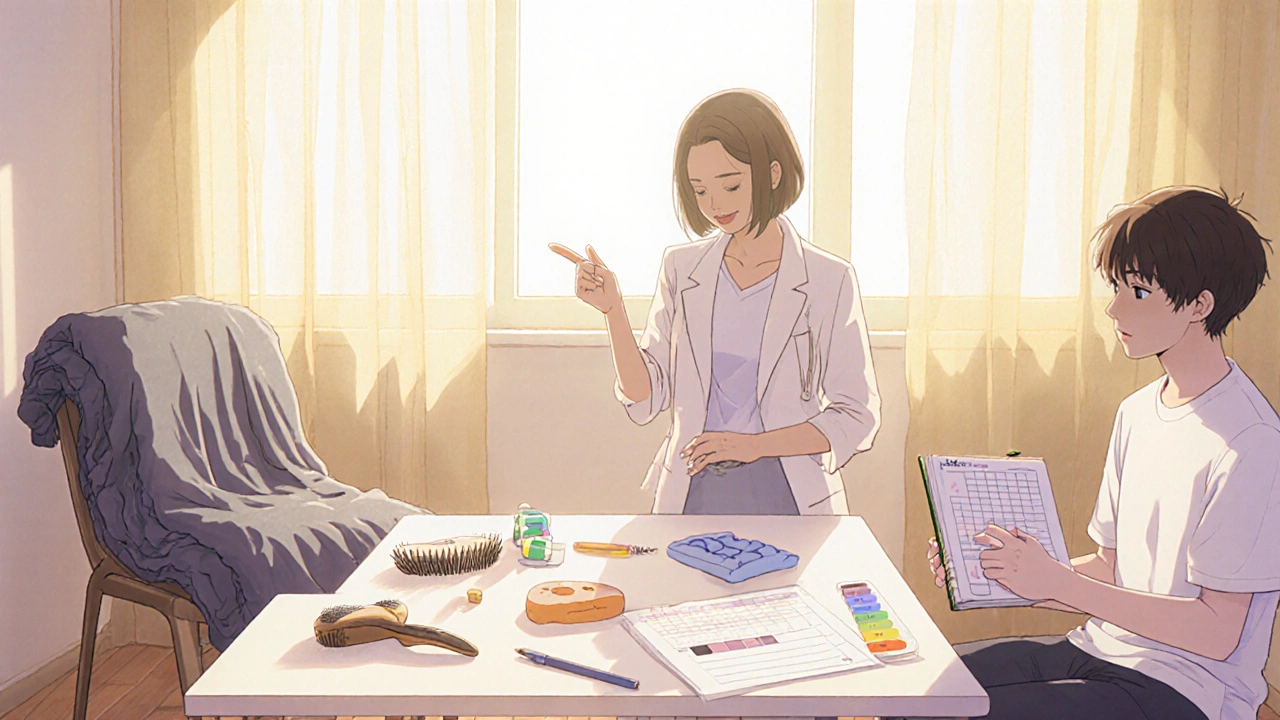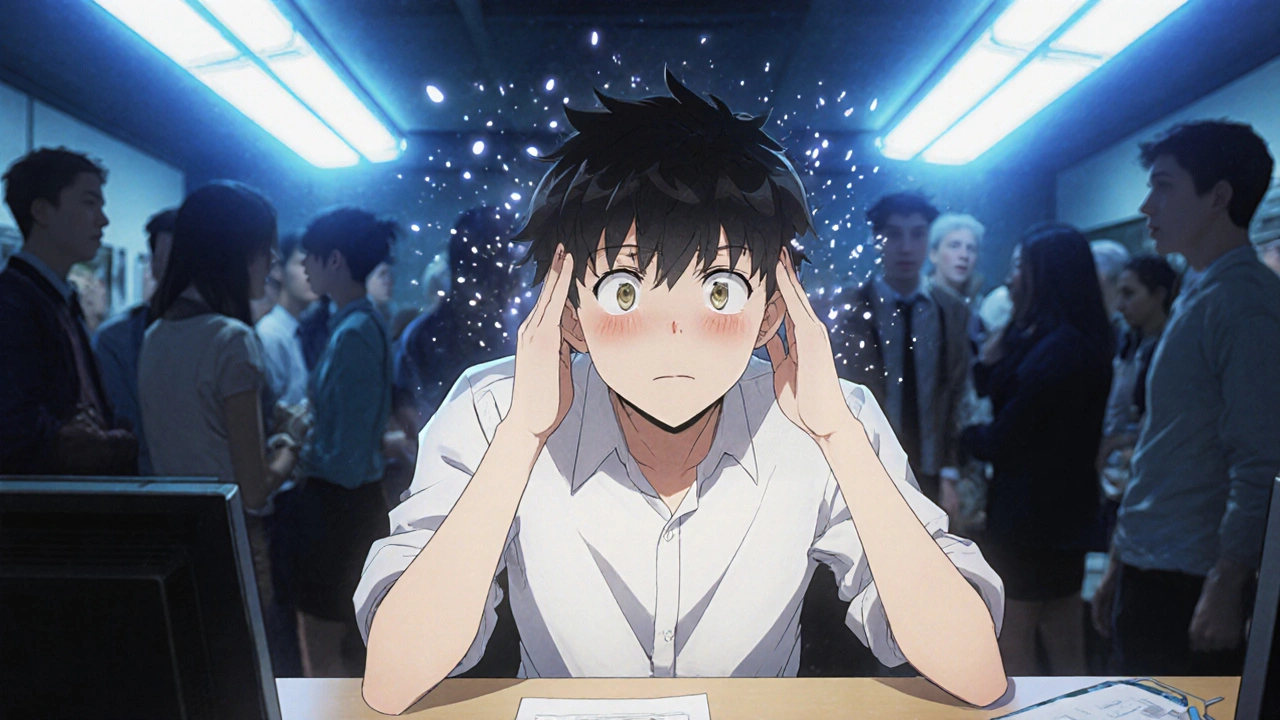ADHD Sensory Overload Planner
Personalized Sensory Management Tool
Identify your personal triggers and create a customized sensory diet to manage ADHD-related overstimulation.
Step 1: Identify Your Triggers
Select the sensory triggers that affect you most:
Step 2: Rate Your Sensitivity
How strongly do these triggers affect you? (1 = Mild, 5 = Severe)
Noise
Visual Clutter
Physical Discomfort
Smells
Unstructured Time
Your Personalized Sensory Diet
Based on your inputs, here's a tailored plan to help manage your sensory needs.
Calming Strategies
Alerting Activities
Proprioceptive Input
Track Your Progress
Log your experience with this plan:
Key Takeaways
- Identify personal sensory triggers early and make simple environment tweaks.
- Use low‑tech tools like noise‑cancelling headphones and fidget toys to stay grounded.
- Structure the day with visual schedules and short movement breaks.
- Work with an occupational therapist to build a personalized sensory diet.
- Track what works, adjust when needed, and celebrate small wins.
When it comes to navigating daily life, ADHD is a neurodevelopmental condition that affects attention, impulse control, and energy levels. Many people with ADHD also experience sensory processing challenges, which can turn ordinary environments into sensory overload zones. If you’re dealing with ADHD overstimulation, these steps can help you stay calm, focused, and productive.
Understanding ADHD and Sensory Processing
ADHD isn’t just about being “hyper” or “distracted.” It’s linked to how the brain regulates dopamine, a chemical that helps filter out irrelevant input. When dopamine levels are low, the brain’s filter weakens, allowing more sensory information to flood in.
Meanwhile, Sensory Processing Disorder (SPD) describes the way the nervous system receives and organizes sensations from touch, sound, sight, taste, and movement. People with SPD may be hypersensitive (everything feels too loud, bright, or rough) or hyposensitive (they crave strong input). The overlap of ADHD and SPD means that everyday stimuli-like a buzzing fluorescent light or a crowded hallway-can quickly become overwhelming.
How Overstimulation Happens
Overstimulation occurs when the brain’s "sensory gate" stays open longer than it should. Imagine trying to have a conversation while a construction crew works right outside your window, the air conditioner is on full blast, and your phone keeps buzzing. For someone with ADHD, each of those stimuli competes for attention, making it hard to focus on any single task.
When the sensory load exceeds a personal threshold, the body reacts with stress hormones, racing thoughts, and physical tension. The result can be irritability, a sudden urge to flee the scene, or a mental shutdown where nothing seems doable.
Everyday Triggers to Watch
Everyone’s trigger list looks different, but here are some common culprits for people juggling ADHD and sensory challenges:
- Noise: loud music, office chatter, traffic, or kitchen appliances.
- Visual clutter: bright fluorescent lighting, busy patterns, or a cluttered desk.
- Physical discomfort: tight clothing, itchy fabrics, or an uncomfortable chair.
- Smells: strong perfumes, cleaning chemicals, or food odors.
- Unstructured time: long gaps between activities can let the mind wander into anxiety.
Knowing which of these spark your stress is the first step toward creating a calmer environment.
Practical Tips for Managing Overstimulation
Create a Low‑Stimulation Workspace
Start by simplifying your immediate surroundings. Swap harsh overhead lights for a desk lamp with warm bulbs. If you can’t control the lighting in a shared space, a pair of noise‑cancelling headphones can mute background chatter without isolating you completely.
Choose a chair with good lumbar support and breathable fabric. If fabric feels itchy, a plain cotton or breathable mesh seat cover can make a big difference.
Use Sensory Tools
Fidget toys aren’t just gimmicks-they give your hands something to do while your brain processes other information. Simple items like a stress ball, a textured strip, or a clicker can reduce the urge to seek out bigger distractions.
When you feel an incoming wave of noise, reach for your headphones, and consider playing low‑frequency white noise or nature sounds. The goal isn’t silence; it’s a predictable, soothing backdrop.
Build Structured Routines & Visual Schedules
Predictability cuts down on surprise sensory input. A visual schedule-a printed chart with icons for each activity-helps the brain know what’s next, reducing anxiety.
Break large tasks into bite‑sized steps. Use timers (e.g., a 15‑minute Pomodoro) to create clear start‑and‑stop points. When the timer dings, give yourself a 2‑minute movement break: stretch, jog in place, or do a quick breathing exercise.
Mindful Breathing & Movement Breaks
Deep, diaphragmatic breathing signals the nervous system to calm. Try the 4‑4‑6 method: inhale for 4 seconds, hold for 4, exhale for 6. Pair it with a gentle shoulder roll or a short walk around the room.
Movement isn’t just a break; it’s a sensory reset. Jumping jacks, a quick yoga flow, or even dancing to a favorite song can help the brain process excess input and return to a more focused state.
Nutrition and Dopamine Support
Since dopamine plays a key role in ADHD, meals that support its production can smooth sensory spikes. Include protein‑rich foods (eggs, beans, lean meat), omega‑3 fatty acids (salmon, walnuts), and complex carbs (sweet potatoes, oats) to keep energy steady.
Avoid high‑sugar snacks that cause rapid spikes and crashes, which can heighten irritability and make sensory overload feel worse.
Working with Professionals
An occupational therapist specializes in sensory integration. They can assess your unique sensitivities and design a personalized sensory diet-a daily plan that mixes calming and alerting activities.
Typical sessions include:
- Identifying specific triggers through observation and questionnaires.
- Introducing tools like weighted blankets, textured brushes, or chewable accessories.
- Teaching self‑regulation techniques that you can use at home or work.
Regular check‑ins help you tweak the plan as life changes (new job, school semester, seasonal shifts).
Building a Personal Sensory Diet
A sensory diet isn’t a strict schedule; it’s a flexible menu of sensory inputs that keep your nervous system balanced. Here’s a starter list you can adapt:
- Calming activities: deep pressure (hugging a pillow), slow rhythmic movement (rocking chair), warm baths.
- Alerting activities: quick jumps, brief sprint, splashing cold water on the face, using a vibrating cushion.
- Proprioceptive input: carrying a weighted backpack, pushing a sturdy chair, using resistance bands.
Schedule a few minutes of each type throughout the day. If a meeting makes you tense, pause for a quick proprioceptive push‑up. If you feel foggy after lunch, sip a cool tea and do a short alerting activity.

Tracking Progress and Adjusting
Use a simple journal or digital note to record:
- What triggered overstimulation (time, place, activity).
- Which tool or technique you used.
- How you felt afterwards (scale 1‑10).
After a week, review the patterns. Are noise‑cancelling headphones consistently helpful? Does a visual schedule reduce stress at work? Celebrate the wins and drop the strategies that don’t move the needle.
Remember, managing overstimulation isn’t a one‑size‑fits‑all project. It’s an ongoing conversation between you, your environment, and any professionals you work with.
Quick Reference Table
| Trigger | Calming Strategy |
|---|---|
| Loud background noise | Noise‑cancelling headphones with white‑noise playlist |
| Bright fluorescent lighting | Desk lamp with warm bulbs; optional clip‑on amber filter |
| Cluttered workspace | Minimalist desk setup; use trays to group items |
| Sudden transitions | Visual schedule with 5‑minute warnings |
| Physical discomfort (tight clothes) | Soft, breathable fabrics; add a seat cushion |
Frequently Asked Questions
Why do people with ADHD feel overwhelmed by sensory input?
ADHD often involves lower dopamine activity, which weakens the brain’s filter for irrelevant stimuli. When the filter is loose, everyday sounds, lights, or textures can pile up, leading to a feeling of overload.
Can sensory tools replace medication?
No. Sensory tools are complements, not substitutes. Medication targets neurochemical pathways, while tools help the nervous system cope with external input. Using both together often yields the best results.
How often should I adjust my sensory diet?
Review it monthly or whenever life changes-new job, school term, season, or after a stressful event. Small tweaks keep the diet effective.
Are there apps that help track sensory triggers?
Yes. Apps like “Sensory Diary,” “Moodnotes,” or generic habit‑trackers can log triggers, tools used, and mood scores. Choose one that feels simple and quick.
What if my workplace can’t accommodate sensory needs?
Start with low‑impact changes: use a personal fan, bring a small plush or fidget, and request a quieter corner if possible. If larger accommodations are needed, discuss them with HR and provide a brief note from your occupational therapist.


Hi, I'm Caden Lockhart, a pharmaceutical expert with years of experience in the industry. My passion lies in researching and developing new medications, as well as educating others about their proper use and potential side effects. I enjoy writing articles on various diseases, health supplements, and the latest treatment options available. In my free time, I love going on hikes, perusing scientific journals, and capturing the world through my lens. Through my work, I strive to make a positive impact on patients' lives and contribute to the advancement of medical science.